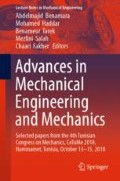Abstract
High quality marble processing is increasingly needed to ensure surface integrity and meet tight geometric and dimensional tolerances encountered in structural, sculpture and decorative industry. The paper aims at determining optimal drilling parameters for white marble in order to minimize the quality characteristic, namely, the circularity and the cylindricity of holes.
The cutting parameters have an influence on the quality of the machined holes. In order to predict the surface integrity of the parts, a calculation method based on Artificial Neural Networks (ANN) has been developed. An architecture comprising six inputs the rotation speed (N), the feed speed (F), the drill bit diameter (BD), the drill bit height (BH), the number of pecking cycles (P), and the drilling depth (BH) and two outputs (circularity and cylindricity) was used. The choice of cutting parameters has an influence on the convergence of the algorithm. The trained ANNs are monitored as regards the mean square error (MSE).
Access this chapter
Tax calculation will be finalised at checkout
Purchases are for personal use only
References
El-Gammal, M.I., Ibrahim, M.S., El-Sayed, A.B., Asker, S.A., El-Galad, N.M.: Health risk assessment of marble dust at marble workshops. Nat. Sci. 9, 144–154 (2011)
Gunaydin, O., Kahraman, S., Fener, M.: Sawability prediction of carbonate rocks from brittleness indexes. J. S. Afr. Inst. Min. Metall. 104, 239–244 (2004)
Abdullah, R., Mahrous, A., Barakat, A.: Surface quality of marble machined by abrasive water jet. Cogent Eng. 3, 239–244 (2016). https://doi.org/10.1080/23311916.2016.1178626
Wang, C.Y., Clausen, R.: Marble cutting with single point cutting tool and diamond segments. Int. J. Mach. Tools Manuf 42, 1045–1054 (2002)
Qiuming, G., Xiuli, D., Zhen, L., Qixin, W.: Development of a mechanical rock breakage experimental platform (2016). https://doi.org/10.1016/j.tust.2016.02.019
Elena, T., Lorenzo, L., Renzo, G., Fabrizio, A.: The decay of the polysiloxane resin Sogesil XR893 applied in the past century for consolidating monumental marble surfaces. J. Cult. Heritage (2017). https://doi.org/10.1016/j.culher.2017.03.001/1296-2074
Yilmaz, O.: The effect of the rock anisotropy on the efficiency of diamond wire cutting machines. Int. J. Rock Mech. Min. Sci. 48, 626–636 (2011)
Shanmuga, D.K., Masood, S.H.: An investigation on kerf characteristics in abrasive waterjet cutting of layered composites. J. Mater. Process. Technol. 20, 3887–3893 (2009)
Lin, H.L.: The use of the Taguchi method and a neural-genetic approach to optimize the quality of a pulsed Nd: YAG laser welding process. Exp. Tech. (2012). https://doi.org/10.1111/j.1747-1567.2012.00849.x
Karataș, C., Sozen, A., Dulek, E.: Modelling of residual stresses in the shot penned material C-1020 by artificial neural network. Expert Syst. Appl. 36, 3514–3521 (2009)
Acknowledgements
The authors are grateful to MARBLE TUNIS-CARTHAGE Company for providing the Ishikawa dossier and their assistance throughout the experimental study.
Author information
Authors and Affiliations
Corresponding author
Editor information
Editors and Affiliations
Rights and permissions
Copyright information
© 2019 Springer Nature Switzerland AG
About this paper
Cite this paper
Abbassi, A., Akrichi, S., Ben Yahia, N. (2019). Application of Artificial Intelligence to Predict Circularity and Cylindricity Tolerances of Holes Drilled on Marble. In: Benamara, A., Haddar, M., Tarek, B., Salah, M., Fakher, C. (eds) Advances in Mechanical Engineering and Mechanics. CoTuMe 2018. Lecture Notes in Mechanical Engineering. Springer, Cham. https://doi.org/10.1007/978-3-030-19781-0_16
Download citation
DOI: https://doi.org/10.1007/978-3-030-19781-0_16
Published:
Publisher Name: Springer, Cham
Print ISBN: 978-3-030-19780-3
Online ISBN: 978-3-030-19781-0
eBook Packages: EngineeringEngineering (R0)

